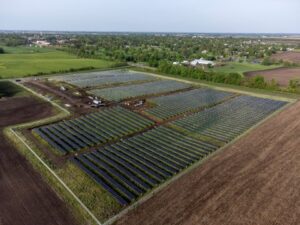Grinnell College was fueled by the dreams of its students, faculty and trustees when it signed the American College & University Presidents’ Climate Commitment a decade ago. With the stroke of a pen from the Iowa college’s former president Raynard Kington, the private liberal arts school in Iowa pledged to begin enacting measures toward carbon neutrality.
“We made a commitment to do this without knowing how we were going to get there, which is always sort of scary,” says Liz Queathem, a biology professor and member of the college’s Fossil Fuels and Climate Impact Task Force.
While leaders lacked a clear path forward, the region was not short on wind and solar energy. Smart networking from Kington helped the institution connect with Trusted Energy, an Iowa-based company and solar panel developer.
“It landed in our lap if you will,” says Chris Bair, Grinnell’s environmental and safety manager and task force member. “Most of the partners were learning as they go.”
Following seven years of negotiation, design and production that survived the pandemic, the 18-acre, 9,000-solar panel array is live, providing up to four megawatts of power to the university. The installation takes care of about one-third of the campus’ total energy needs as one megawatt is enough to power up to 750 houses.
The project ultimately reduces the college’s yearly carbon footprint by 18% and brings the institution one step closer to its pledge to reach net-zero greenhouse gas emissions by 2040, a mission enshrined in its 2030 strategic plan. Moreover, Grinnell will save over $3 million in energy costs over its 20-year contract agreement with Trusted Energy.
“It’s so exciting that our students have been behind this every step of the way and we have the full support of the board of trustees,” Queathem says.
Big goals, small college

Grinnell is no stranger to solar power. It currently sports five solar installations on campus connected to building rooftops. One of those arrays—combined with a wind turbine—has made Grinnell’s Environmental Education Building the first net-zero facility on campus.
However, its newest installation is a big step up, being the largest privately owned solar project in the state. Cost is the primary barrier to entry for such a large installation, which can come with a multi-million dollar price tag.
“A lot of institutions are not able to get things like this going,” says Queathem, “either because of where they’re located or because they’re having other financial issues.”
More from UB: 3 big questions are lingering after NCAA’s landmark case
Luckily the institution wasn’t responsible for any upfront construction costs. Sunlight General Capital LLC, the owner of the solar panel installation, agreed to eat construction costs in exchange for its associated tax breaks, as well as the monthly payments it will receive on the produced electricity. And while Grinnell will have to buy its power from Trusted Energy per its contract, the college has found a clever way to avoid a high utility bill by offloading solar panel energy production during peak power demand to a recently installed 600 kW Tesla battery.
Queathem credits the college’s financial resourcefulness to its board of trustees, most of whom once attended the college and had to weigh the costs of being green against their aspirations for a more conscientious institution.

“They were sort of in the middle, but everybody acknowledged that climate change is the biggest defining problem of our time,” she says. “It’s the biggest problem on Earth. Everybody’s going to suffer from it if we don’t do something about it.”
Nevertheless, development posed a series of challenges. While the solar panels were originally planned to go live years earlier, the pandemic stalled production, creating a race against time, Bair says. “The solar market right now is changing so fast that if you have a project that goes well beyond a couple of years, the technology is just different by the time you turn it on.”
The sheer amount of land necessary for the project also posed a challenge. Luckily, Grinnell had already been setting aside land for an agricultural project involving sheep grazing.
“There are a lot of things that took a while, but it all seemed to come together,” Bair says.
A new solar panel project at Grinnell College unfolds
While the installation with Trusted Energy and Sunlight General is finally operational, Grinnell has also recently purchased a piece of land allowing it to participate in the city’s recently announced solar panel project. Constructed across the west edge of town, the city’s utility company will be able to provide the college another two megawatts of solar power a year over the next two to three decades, Bair says.
Once completed, the project will bring campus energy consumption to over 50% renewably sourced, according to a university statement.
“Not only are we [reducing] our carbon footprint, but our utility company is also becoming greener,” Queathem says. “That’s also going to push us toward our sustainability goals.”








